Check Citroen C5 RHD 2011.5 (RD/TD) / 2.G User Guide
[x] Cancel search | Manufacturer: CITROEN, Model Year: 2011.5, Model line: C5 RHD, Model: Citroen C5 RHD 2011.5 (RD/TD) / 2.GPages: 340, PDF Size: 39.33 MB
Page 43 of 340
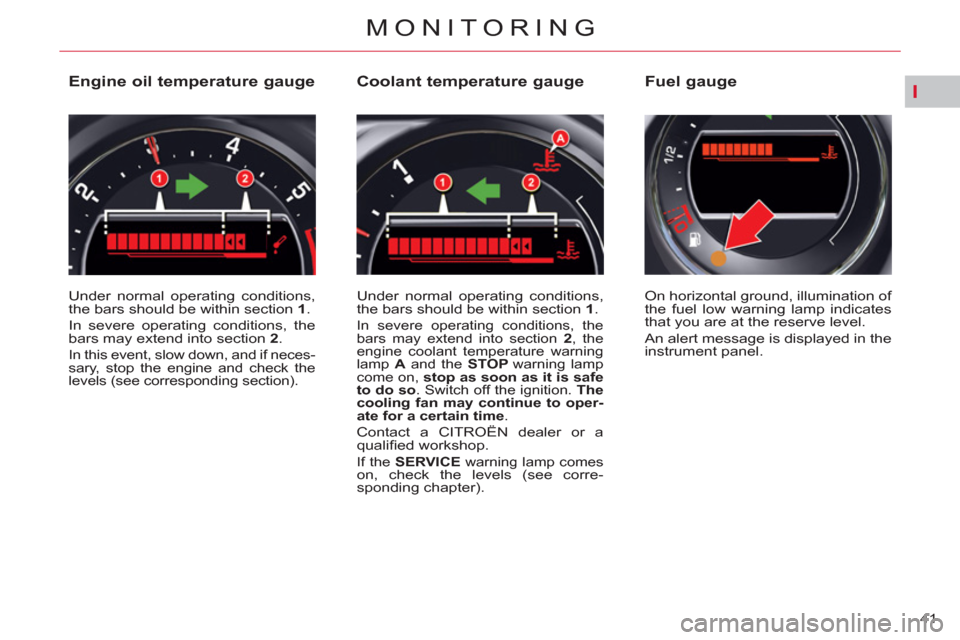
I
41
MONITORING
Engine oil temperature gauge
Under normal operating conditions,
the bars should be within section 1
.
In severe operating conditions, the
bars may extend into section 2
.
In this event, slow down, and if neces-
sary, stop the engine and check the
levels (see corresponding section).
Coolant temperature gauge
Under normal operating conditions,
the bars should be within section 1
.
In severe operating conditions, the
bars may extend into section 2
, the
engine coolant temperature warning
lamp A
and the STOP
warning lamp
come on, stop as soon as it is safe
to do so
. Switch off the ignition. The
cooling fan may continue to oper-
ate for a certain time
.
Contact a CITROËN dealer or a
qualifi ed workshop.
If the SERVICE
warning lamp comes on, check the levels (see corre-
sponding chapter). On horizontal ground, illumination of
the fuel low warning lamp indicates
that you are at the reserve level.
An alert message is displayed in the
instrument panel.
Fuel gauge
Page 52 of 340
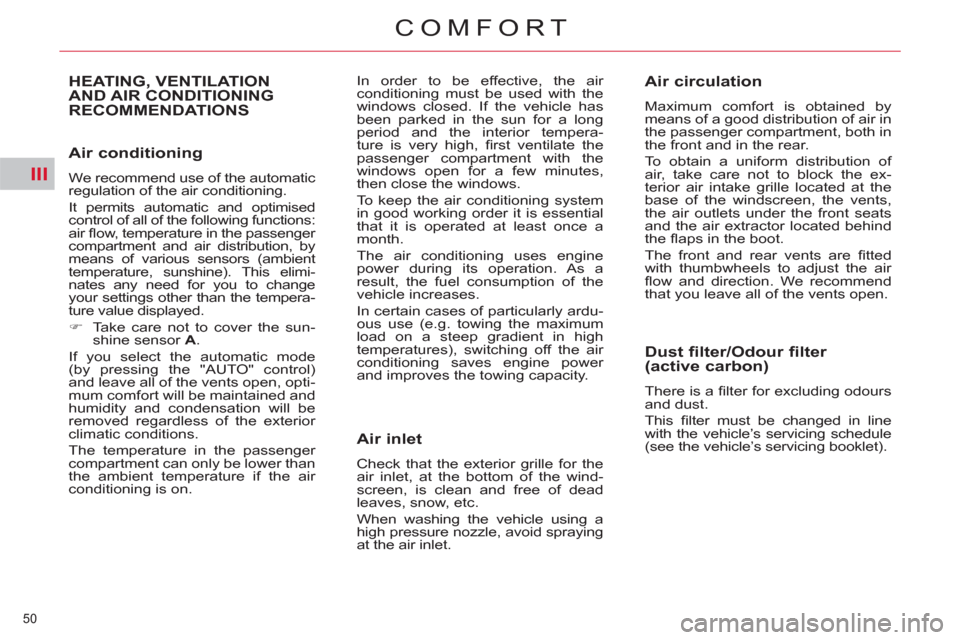
III
50
COMFORT
Air conditioning
We recommend use of the automatic
regulation of the air conditioning.
It permits automatic and optimised
control of all of the following functions:
air fl ow, temperature in the passenger
compartment and air distribution, by
means of various sensors (ambient
temperature, sunshine). This elimi-
nates any need for you to change
your settings other than the tempera-
ture value displayed.
�)
Take care not to cover the sun-
shine sensor A
.
If you select the automatic mode
(by pressing the "AUTO" control)
and leave all of the vents open, opti-
mum comfort will be maintained and
humidity and condensation will be
removed regardless of the exterior
climatic conditions.
The temperature in the passenger
compartment can only be lower than
the ambient temperature if the air
conditioning is on.
HEATING, VENTILATION
AND AIR CONDITIONING
RECOMMENDATIONS In order to be effective, the air
conditioning must be used with the
windows closed. If the vehicle has
been parked in the sun for a long
period and the interior tempera-
ture is very high, fi rst ventilate the
passenger compartment with the
windows open for a few minutes,
then close the windows.
To keep the air conditioning system
in good working order it is essential
that it is operated at least once a
month.
The air conditioning uses engine
power during its operation. As a
result, the fuel consumption of the
vehicle increases.
In certain cases of particularly ardu-
ous use (e.g. towing the maximum
load on a steep gradient in high
temperatures), switching off the air
conditioning saves engine power
and improves the towing capacity.
Air inlet
Check that the exterior grille for the
air inlet, at the bottom of the wind-
screen, is clean and free of dead
leaves, snow, etc.
When washing the vehicle using a
high pressure nozzle, avoid spraying
at the air inlet.
Air circulation
Maximum comfort is obtained by
means of a good distribution of air in
the passenger compartment, both in
the front and in the rear.
To obtain a uniform distribution of
air, take care not to block the ex-
terior air intake grille located at the
base of the windscreen, the vents,
the air outlets under the front seats
and the air extractor located behind
the fl aps in the boot.
The front and rear vents are fi tted
with thumbwheels to adjust the air
fl ow and direction. We recommend
that you leave all of the vents open.
Dust filter/Odour filter
(active carbon)
There is a fi lter for excluding odours
and dust.
This fi lter must be changed in line
with the vehicle’s servicing schedule
(see the vehicle’s servicing booklet).
Page 68 of 340
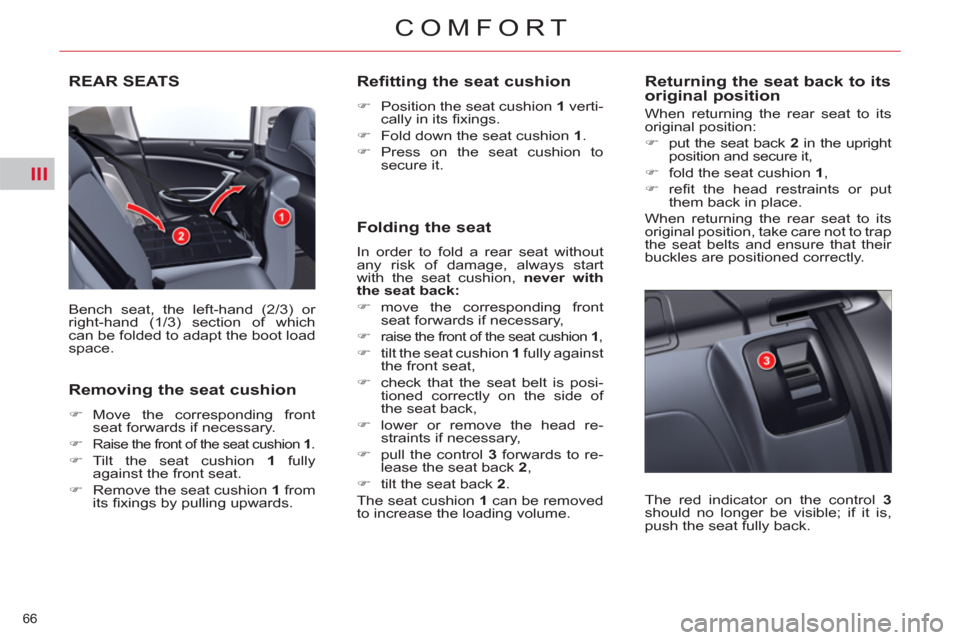
III
66
COMFORT
REAR SEATS
Bench seat, the left-hand (2/3) or
right-hand (1/3) section of which
can be folded to adapt the boot load
space.
Removing the seat cushion
�)
Move the corresponding front
seat forwards if necessary.
�)
Raise the front of the seat cushion 1
.
�)
Tilt the seat cushion 1
fully
against the front seat.
�)
Remove the seat cushion 1
from
its fi xings by pulling upwards.
Refitting the seat cushion
�)
Position the seat cushion 1
verti-
cally in its fi xings.
�)
Fold down the seat cushion 1
.
�)
Press on the seat cushion to
secure it.
Folding the seat
In order to fold a rear seat without
any risk of damage, always start
with the seat cushion, never with
the seat back:
�)
move the corresponding front
seat forwards if necessary,
�)
raise the front of the seat cushion 1
,
�)
tilt the seat cushion 1
fully against
the front seat,
�)
check that the seat belt is posi-
tioned correctly on the side of
the seat back,
�)
lower or remove the head re-
straints if necessary,
�)
pull the control 3
forwards to re-
lease the seat back 2
,
�)
tilt the seat back 2
.
The seat cushion 1
can be removed
to increase the loading volume.
Returning the seat back to its
original position
When returning the rear seat to its
original position:
�)
put the seat back 2
in the upright
position and secure it,
�)
fold the seat cushion 1
,
�)
refi t the head restraints or put
them back in place.
When returning the rear seat to its
original position, take care not to trap
the seat belts and ensure that their
buckles are positioned correctly.
The red indicator on the control 3
should no longer be visible; if it is,
push the seat fully back.
Page 77 of 340
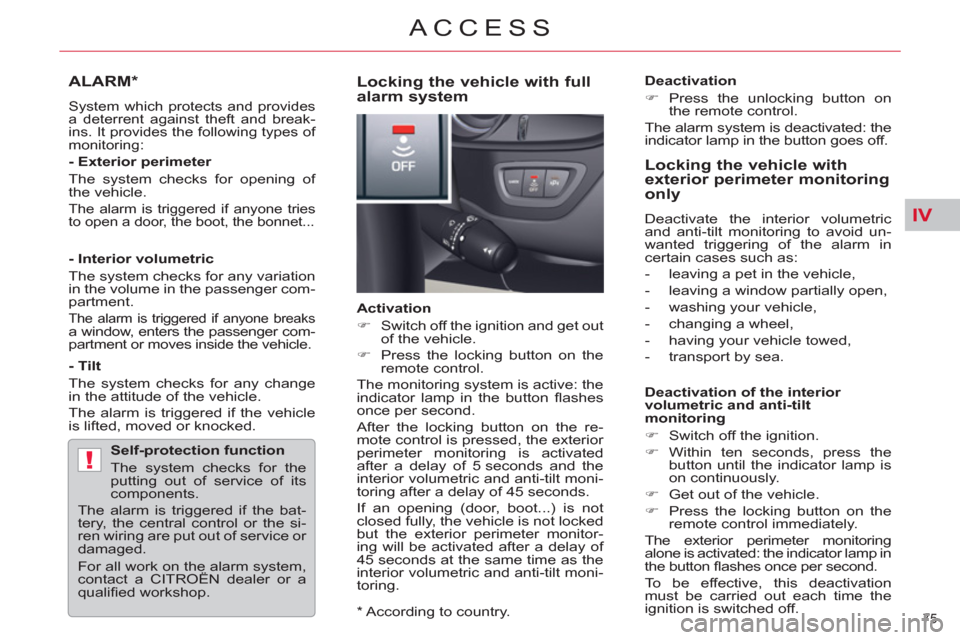
IV
!
75
ACCESS
ALARM *
System which protects and provides
a deterrent against theft and break-
ins. It provides the following types of
monitoring:
- Exterior perimeter
The system checks for opening of
the vehicle.
The alarm is triggered if anyone tries
to open a door, the boot, the bonnet...
- Interior volumetric
The system checks for any variation
in the volume in the passenger com-
partment.
The alarm is triggered if anyone breaks a window, enters the passenger com-
partment or moves inside the vehicle.
- Tilt
The system checks for any change
in the attitude of the vehicle.
The alarm is triggered if the vehicle
is lifted, moved or knocked.
Self-protection function
The system checks for the
putting out of service of its
components.
The alarm is triggered if the bat-
tery, the central control or the si-
ren wiring are put out of service or
damaged.
For all work on the alarm system,
contact a CITROËN dealer or a
qualifi ed workshop.
Locking the vehicle with full
alarm system
Activation
�)
Switch off the ignition and get out
of the vehicle.
�)
Press the locking button on the
remote control.
The monitoring system is active: the
indicator lamp in the button fl ashes
once per second.
After the locking button on the re-
mote control is pressed, the exterior
perimeter monitoring is activated
after a delay of 5 seconds and the
interior volumetric and anti-tilt moni-
toring after a delay of 45 seconds.
If an opening (door, boot...) is not
closed fully, the vehicle is not locked
but the exterior perimeter monitor-
ing will be activated after a delay of
45 seconds at the same time as the
interior volumetric and anti-tilt moni-
toring.
Deactivation
�)
Press the unlocking button on
the remote control.
The alarm system is deactivated: the
indicator lamp in the button goes off.
Locking the vehicle with
exterior perimeter monitoring
only
Deactivate the interior volumetric
and anti-tilt monitoring to avoid un-
wanted triggering of the alarm in
certain cases such as:
- leaving a pet in the vehicle,
- leaving a window partially open,
- washing your vehicle,
- changing a wheel,
- having your vehicle towed,
- transport by sea.
Deactivation of the interior
volumetric and anti-tilt
monitoring
�)
Switch off the ignition.
�)
Within ten seconds, press the
button until the indicator lamp is
on continuously.
�)
Get out of the vehicle.
�)
Press the locking button on the
remote control immediately.
The exterior perimeter monitoring
alone is activated: the indicator lamp in
the button fl ashes once per second.
To be effective, this deactivation
must be carried out each time the
ignition is switched off.
*
According to country.
Page 78 of 340
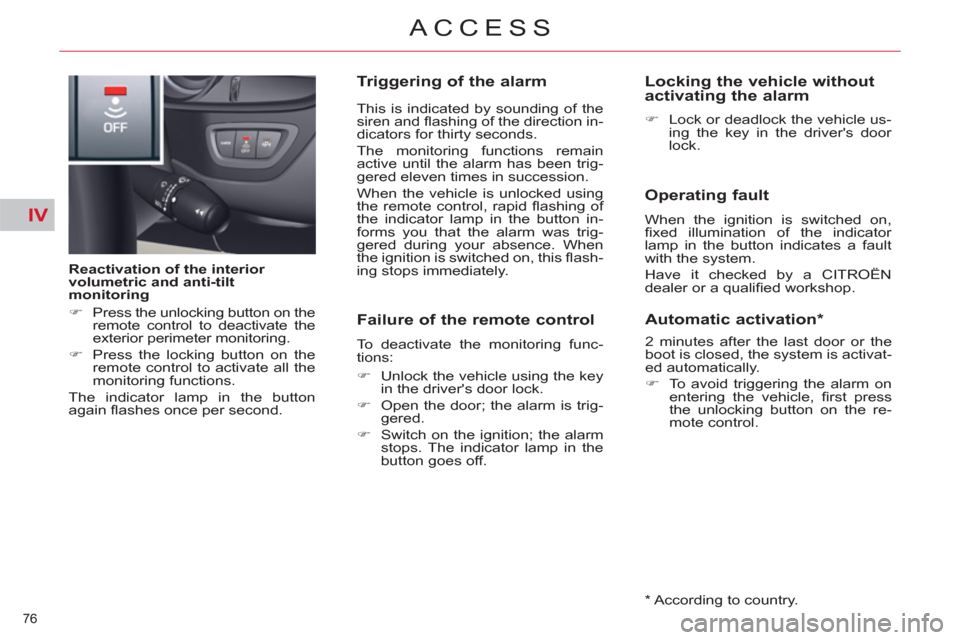
IV
76
ACCESS
Reactivation of the interior
volumetric and anti-tilt
monitoring
�)
Press the unlocking button on the
remote control to deactivate the
exterior perimeter monitoring.
�)
Press the locking button on the
remote control to activate all the
monitoring functions.
The indicator lamp in the button
again fl ashes once per second.
Triggering of the alarm
This is indicated by sounding of the
siren and fl ashing of the direction in-
dicators for thirty seconds.
The monitoring functions remain
active until the alarm has been trig-
gered eleven times in succession.
When the vehicle is unlocked using
the remote control, rapid fl ashing of
the indicator lamp in the button in-
forms you that the alarm was trig-
gered during your absence. When
the ignition is switched on, this fl ash-
ing stops immediately.
Failure of the remote control
To deactivate the monitoring func-
tions:
�)
Unlock the vehicle using the key
in the driver's door lock.
�)
Open the door; the alarm is trig-
gered.
�)
Switch on the ignition; the alarm
stops. The indicator lamp in the
button goes off.
Locking the vehicle without
activating the alarm
�)
Lock or deadlock the vehicle us-
ing the key in the driver's door
lock.
Operating fault
When the ignition is switched on,
fi xed illumination of the indicator
lamp in the button indicates a fault
with the system.
Have it checked by a CITROËN
dealer or a qualifi ed workshop.
Automatic activation *
2 minutes after the last door or the
boot is closed, the system is activat-
ed automatically.
�)
To avoid triggering the alarm on
entering the vehicle, fi rst press
the unlocking button on the re-
mote control.
*
According to country.
Page 80 of 340

IV
78
ACCESS
Reinitialisation
If a window does not rise automati-
cally, its operation must be reini-
tialised:
�)
pull the control until the window
stops,
�)
release the control and pull it
again until the window closes
fully,
�)
continue to hold the control for
approximately one second after
the window has closed,
�)
press the control to lower the
window automatically to the low
position,
�)
when the window has reached
the low position, press the con-
trol again for approximately one
second.
The safety anti-pinch function
is not operational during these
operations.
Deactivation of the rear
electric window and door
controls
�)
For the safety of your children,
press control 5
to deactivate the
rear electric window controls re-
gardless of their position.
Indicator lamp on, the rear controls
are deactivated.
Indicator lamp off, the rear controls
are activated. Always remove the key from the
ignition when leaving the vehicle,
even for a short time.
If an obstacle is encountered during operation of the electric windows,
you must reverse the movement of
the window. To do this, press the
control concerned.
When the driver operates the con-
trols for the passengers' electric
windows, they must ensure that no
one is preventing correct closing of
the windows.
The driver must ensure that the
passengers use the electric win-
dows correctly.
Be aware of children when operating
the windows. A message in the instrument panel
screen informs you of the activation/
deactivation of the control. This control also deactivates the
interior controls for the rear doors
(refer to the section "Child safety - §
Electric child lock").
Any other status of the indicator
lamp indicates a fault with the elec-
tric child lock.
Have it checked by a CITROËN
dealer or a qualifi ed workshop.
Page 82 of 340
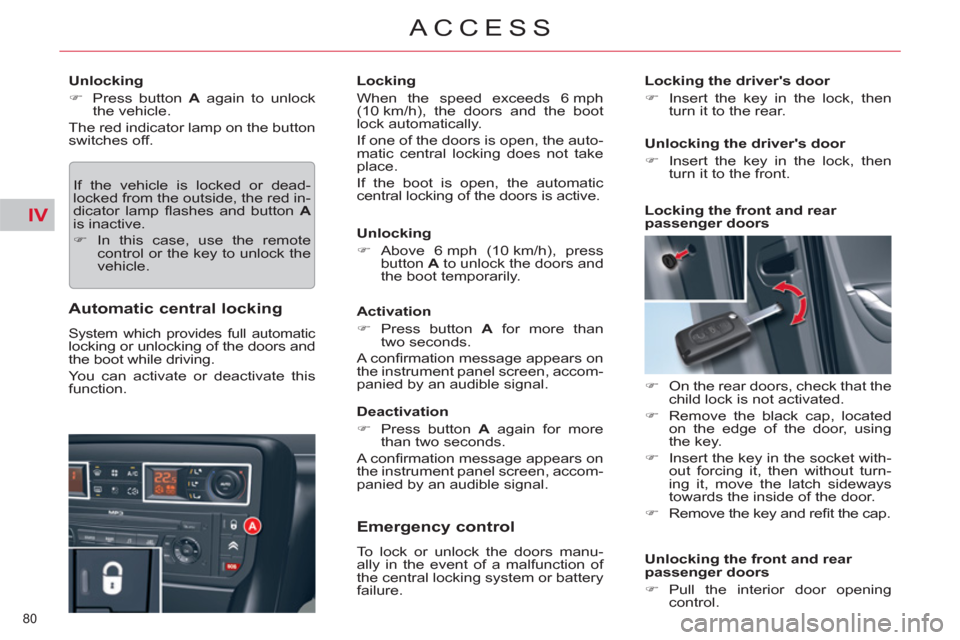
IV
80
ACCESS
Unlocking
�)
Press button A
again to unlock
the vehicle.
The red indicator lamp on the button
switches off.
If the vehicle is locked or dead-
locked from the outside, the red in-
dicator lamp fl ashes and button A
is inactive.
�)
In this case, use the remote
control or the key to unlock the
vehicle.
Automatic central locking
System which provides full automatic locking or unlocking of the doors and
the boot while driving.
You can activate or deactivate this
function.
Locking
When the speed exceeds 6 mph
(10 km/h), the doors and the boot
lock automatically.
If one of the doors is open, the auto-
matic central locking does not take
place.
If the boot is open, the automatic
central locking of the doors is active.
Unlocking
�)
Above 6 mph (10 km/h), press
button A
to unlock the doors and
the boot temporarily.
Activation
�)
Press button A
for more than
two seconds.
A confi rmation message appears on
the instrument panel screen, accom-
panied by an audible signal.
Deactivation
�)
Press button A
again for more
than two seconds.
A confi rmation message appears on
the instrument panel screen, accom-
panied by an audible signal.
Emergency control
To lock or unlock the doors manu-
ally in the event of a malfunction of
the central locking system or battery
failure.
Locking the driver's door
�)
Insert the key in the lock, then
turn it to the rear.
Unlocking the driver's door
�)
Insert the key in the lock, then
turn it to the front.
Locking the front and rear
passenger doors
�)
On the rear doors, check that the
child lock is not activated.
�)
Remove the black cap, located
on the edge of the door, using
the key.
�)
Insert the key in the socket with-
out forcing it, then without turn-
ing it, move the latch sideways
towards the inside of the door.
�)
Remove the key and refi t the cap.
Unlocking the front and rear
passenger doors
�)
Pull the interior door opening
control.
Page 97 of 340
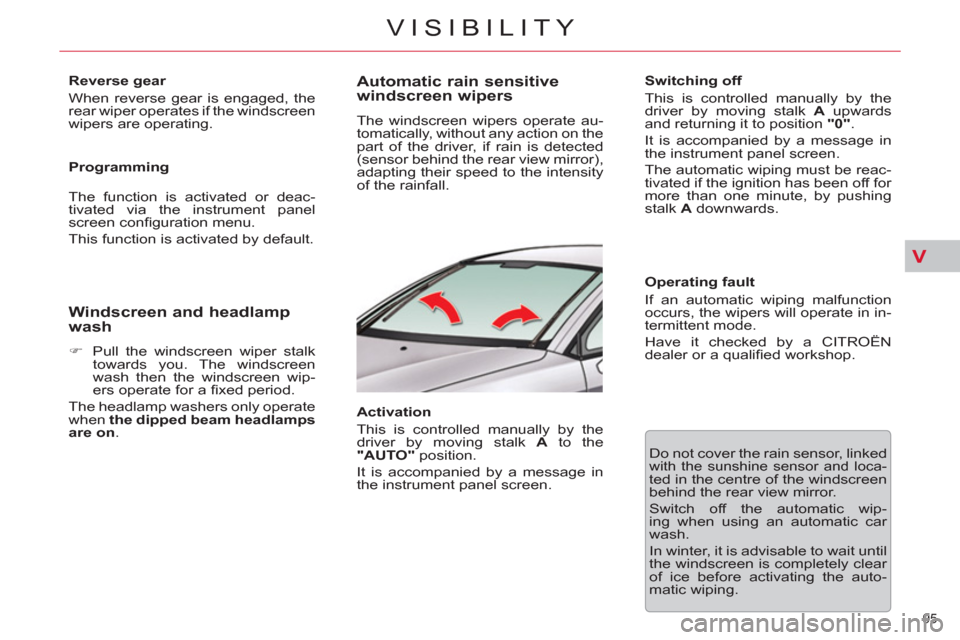
V
95
VISIBILITY
Reverse gear
When reverse gear is engaged, the
rear wiper operates if the windscreen
wipers are operating.
Programming
The function is activated or deac-
tivated via the instrument panel
screen confi guration menu.
This function is activated by default.
Windscreen and headlamp
wash
�)
Pull the windscreen wiper stalk
towards you. The windscreen
wash then the windscreen wip-
ers operate for a fi xed period.
The headlamp washers only operate
when the dipped beam headlamps
are on
.
Automatic rain sensitive
windscreen wipers
The windscreen wipers operate au-
tomatically, without any action on the
part of the driver, if rain is detected
(sensor behind the rear view mirror),
adapting their speed to the intensity
of the rainfall.
Activation
This is controlled manually by the
driver by moving stalk A
to the
"AUTO"
position.
It is accompanied by a message in
the instrument panel screen.
Switching off
This is controlled manually by the
driver by moving stalk A
upwards
and returning it to position "0"
.
It is accompanied by a message in
the instrument panel screen.
The automatic wiping must be reac-
tivated if the ignition has been off for
more than one minute, by pushing
stalk A
downwards.
Operating fault
If an automatic wiping malfunction
occurs, the wipers will operate in in-
termittent mode.
Have it checked by a CITROËN
dealer or a qualifi ed workshop.
Do not cover the rain sensor, linked
with the sunshine sensor and loca-
ted in the centre of the windscreen
behind the rear view mirror.
Switch off the automatic wip-
ing when using an automatic car
wash.
In winter, it is advisable to wait until
the windscreen is completely clear
of ice before activating the auto-
matic wiping.
Page 103 of 340
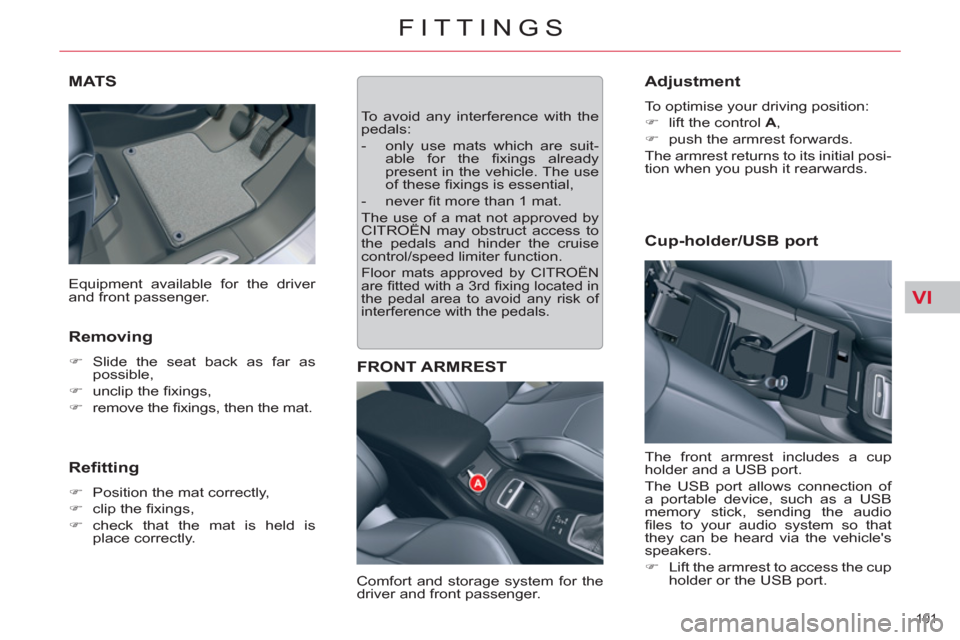
VI
101
FITTINGS
MATS
Removing
�)
Slide the seat back as far as
possible,
�)
unclip the fi xings,
�)
remove the fi xings, then the mat.
Refitting
�)
Position the mat correctly,
�)
clip the fi xings,
�)
check that the mat is held is
place correctly.
To avoid any interference with the
pedals:
- only use mats which are suit-
able for the fi xings already
present in the vehicle. The use
of these fi xings is essential,
- never fi t more than 1 mat.
The use of a mat not approved by
CITROËN may obstruct access to
the pedals and hinder the cruise
control/speed limiter function.
Floor mats approved by CITROËN
are fi tted with a 3rd fi xing located in
the pedal area to avoid any risk of
interference with the pedals.
FRONT ARMREST
Comfort and storage system for the
driver and front passenger.
Adjustment
To optimise your driving position:
�)
lift the control A
,
�)
push the armrest forwards.
The armrest returns to its initial posi-
tion when you push it rearwards.
The front armrest includes a cup
holder and a USB port.
The USB port allows connection of
a portable device, such as a USB
memory stick, sending the audio
fi les to your audio system so that
they can be heard via the vehicle's
speakers.
�)
Lift the armrest to access the cup
holder or the USB port.
Equipment available for the driver
and front passenger.
Cup-holder/USB port
Page 107 of 340

VI
105
FITTINGS
LUGGAGE COVER (TOURER)
To roll up
�)
Press the handle (PRESS) gently.
The luggage cover rolls up auto-
matically.
The moving part A
can be folded
along the rear bench seat backrest.
To remove
�)
Compress the control 1
and lift
the luggage cover on the right
then on the left to remove it.
To install
�)
Position the left-hand end of the
luggage cover roller in its loca-
tion B
behind the rear bench
seat.
�)
Compress the roller control 1
and put the roller in place in its
location C
on the right.
�)
Release the control to secure
the luggage cover.
�)
Unroll it to its fastening on the
rear pillar.
High load retaining net
(Tourer)
Hooked onto the special upper and
lower fi xings, this permits use of the
entire loading volume up to the roof:
- behind the rear seats (row 2),
- behind the front seats (row 1)
when the rear seats are folded.
When positioning the net, check that
the strap loops are visible from the
boot; this will make slackening or
tightening easier.